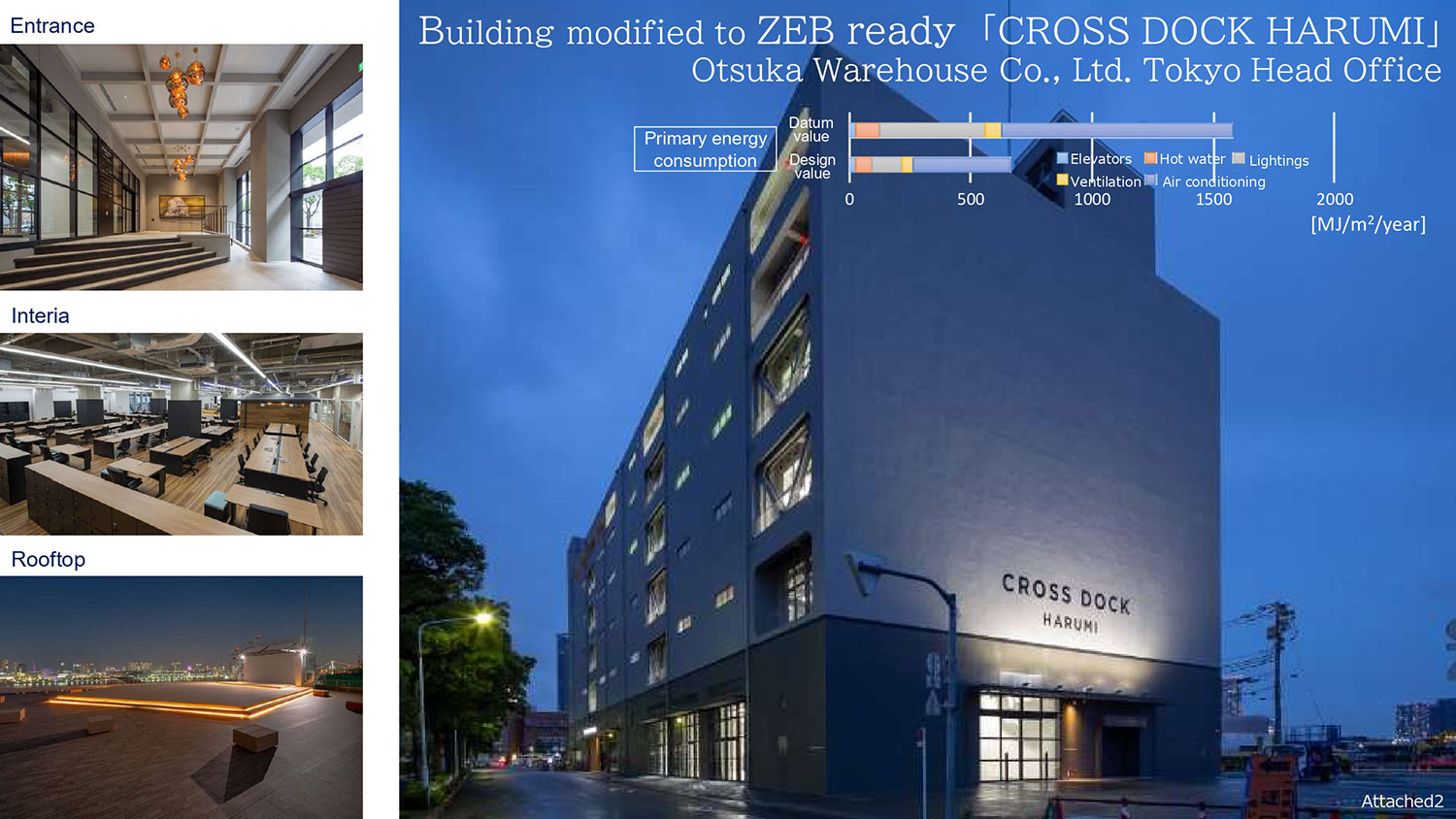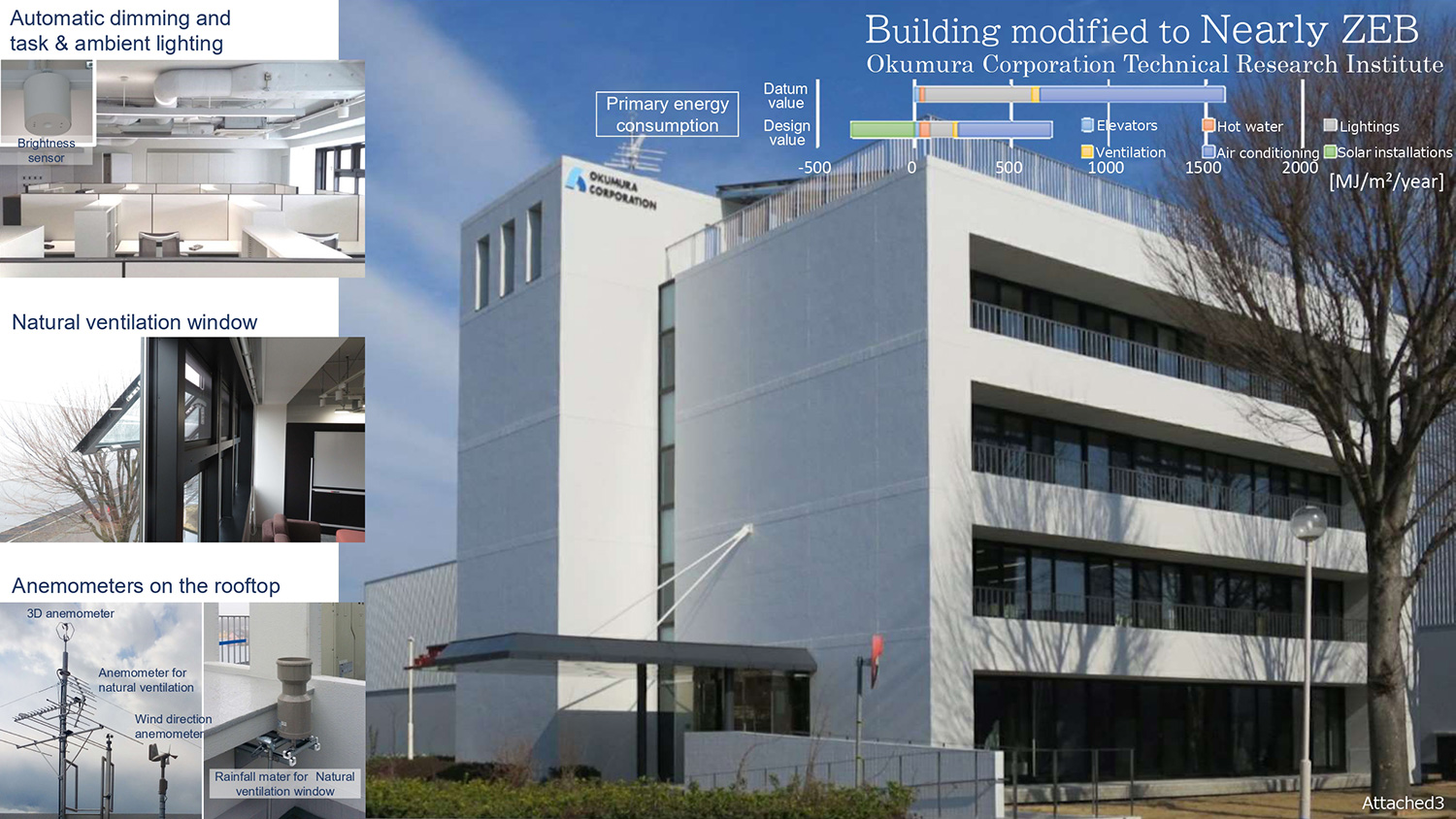Realizing and Propagating PEBs (Positive Energy Buildings) Utilizing ICT and AI
Okumura Corporation
Outline
The Strategic Energy Plan approved by the Japanese government in 2018 includes the target of achieving ZEBs (net zero energy buildings) on average for newly constructed buildings by 2030 (1). Based on its Challenge Zero declaration, Okumura Corporation is seeking to contribute to a zero-emission society by realizing and promoting positive energy buildings (PEBs) (2), which offer higher energy performance than ZEBs, by 2050.
Okumura Corporation is working toward the following targets to make PEBs a reality:
2030:
Developing comfort sensing and control technologies based on information and communication technology (ICT) and AI to achieve ZEB, with the use of new indoor environmental test facilities to be constructed in May 2020
2040:
Real-world implementation of PEB through the development of an optimal energy management system (EMS) to integrate various facilities
2050:
Propagating PEBs by lowering EMS costs and through active proposals for use in design and construction projects
Description
1. ZEB feasibility
The Strategic Energy Plan approved by the Japanese government currently includes a target of achieving ZEBs (net zero energy buildings) on average for newly constructed buildings by 2030. Here, “ZEB” encompasses the concepts of “ZEB,” in which primary energy consumption is reduced to net zero through energy conservation and energy generating, “nearly ZEB,” in which primary energy consumption is reduced by at least 75 % compared to the datum value through energy conservation and energy generating, and “ZEB ready,” in which primary energy consumption is reduced by at least 50 % compared to the datum value through energy conservation. Achieving ZEBs with a net zero primary energy consumption is generally regarded to be difficult in cases involving large high-rise buildings with a relatively small area for installation of energy supply equipment relative to total floor area (2).
2. The need for PEBs
To achieve a zero-emission society by 2050, Okumura Corporation believes it is essential to make PEBs a reality for mid- to low-rise buildings, with their positive energy balance, and then to achieve net zero primary energy consumption for buildings over an entire area by supplying energy under microgrid control (3) to the large high-rise buildings for which achieving ZEB status is problematic. This is why Okumura Corporation is committed to making PEBs a practical and widespread solution by 2050.
3. Methods for PEB realization
To make PEBs reality, building energy consumption must be reduced to as close as zero as possible, while surplus renewable energy must be increased. While the efficiency of energy conservation and energy generating facilities is expected to improve, early realization of PEBs requires initiatives to optimize energy for the entire building. To this end, we intend to focus on three methods: ①Developing comfort sensing and control technologies using ICT and AI; ②optimizing the entire building using optimal EMS to integrate various facilities; and ③introducing microgrid control and cost reductions for overall systems, including EMS.
① Developing comfort sensing and control technologies using ICT and AI
The design criteria for maintaining comfort within spaces generally involve control to levels that do not result in discomfort within a room. However, Society 5.0 (4) proposes a society =“capable of responding to a wide range of needs,” making it essential in the future to provide differing environments to suit the individual needs of persons within the building, while minimizing energy consumption. Previously, Okumura Corporation focused on the correlation between the comfort of thermal environments and temperature fluctuations over time. Okumura has worked on projects to develop energy-saving air-conditioning control technologies that utilize this relationship (5). We hope to use ICT and AI in the future to achieve further energy savings through optimal control of facilities and by sensing comfort with respect to light and airflow environments, as well as thermal environments.
② Optimization of entire building using optimal EMS to integrate various facilities
Overall optimization integrating all facilities in a building has also emerged as a key focus, in place of simply controlling facilities independently. Building facilities consist not just of equipment like air conditioning, fans, and lighting, which converts energy into heat, airflow, and light, but also include equipment such as automatically opening and closing windows and automatically controlled blinds designed to harmonize between the exterior and interior environments. It’s the combined effectiveness of all the factors that determine energy consumption. Research on the correlation of the effects of such facilities may lead to optimization to achieve a system that allows the best possible use of natural energy. The issue of processing the huge volumes of data collected by sensing poses issues, but this can be overcome by combining edge computing with extrapolation from large volumes of data using AI.
③ Introducing microgrid control and cost reductions for overall systems, including EMS
For the most part, EMS for buildings consists of high cost systems intended for large-scale buildings. Little progress has been made in adopting EMS to small or medium size buildings, which represent most buildings in Japan. Future smart city initiatives (3) will lead to increased adoption of area energy management systems (AEMS) designed to enable microgrid control, even in small or medium size buildings. Our goal is to work with power generating companies to achieve coordination with AEMS and reduce system costs.(Attached1)
4. Attainment targets
2030:Development of comfort sensing and control technology utilizing ICT and AI to
achieve ZEB
2040:Practical implementation of PEB through development of optimal EMS to
integrate various facilities
2050:Propagation of PEBs by lowering EMS costs and through active proposals for use in design and construction projects
5. Future initiatives (specific actions)
Okumura has already achieved ZEB ready (6) and Nearly ZEB (7) in its design projects. (Attached2,3) We plan to develop comfort sensing and control technologies utilizing ICT and AI to achieve ZEB in the near future. The facility for environment experiments operating from May 2020 at the Okumura Corporation Technical Research Institute allows testing of thermal, light, and airflow environments in large spaces, such as open-plan offices and wellholes. This facility will be used for research and development on various kinds of environmental control technologies.
Supplementary information
(1) https://www.enecho.meti.go.jp/category/others/basic_plan/pdf/180703.pdf
(2) https://www.env.go.jp/earth/earth/ondanka/zeb/03.pdf
(3) https://www.mlit.go.jp/common/001249774.pdf
(4) https://www8.cao.go.jp/cstp/society5_0/index.html
(5) http://www.jice.or.jp/award/detail/108
(6) https://sii.or.jp/file/zeb_leading_owner/ZEB29L-00047-P_01.pdf
(7) http://www.okumuragumi.co.jp/newsrelease/data/200226.pdf
Other Innovation Challenges
Similar Innovation Challenges
Accelarating the penetration of renewable energy resources with “Open Energy System”
Sony Group Corporation
Achieving net-zero carbon emissions from plant factories using full artificial lighting
Taikisha Ltd.
Advanced technology for buildings providing energy-saving and comfortable indoor environment (under Net Zero Energy condition)
Mitsubishi Electric Corporation
AI control reduces base station power consumption by up to 50%
KDDI CORPORATION









